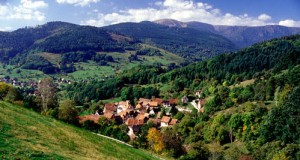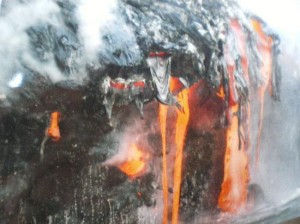We’ve already delved into how the size of the city, and the city’s residents, can help establish its importance and make it all the more engaging for your players. Remember, a city that makes sense adds that touch of reality to your fantasy world that can help immerse your players in your world.
What about where the city is? This is often my first step when designing new cities for my campaign world. I draw my map. I have a rough idea of the geography already, and I place the important sites I know I’ll need for my campaign. Then I end up with all this white space, so I start placing dots.
This practice can be good and bad. It’s bad because as a designer and a fan of history, I’d like to think that every civilization has a grand backstory of choices and migrations that came together to ultimately settle a spot with really good reasons. The designer in me would almost like to leave that area blank in the absence of grand inspiration.
It’s good because I want to fill the area with dots for a reason. I expect a certain amount of the map to be settled, and unless it’s a plot or setting feature, my players will expect the same. Placing dots forces me to work creatively to add that purpose. A great starting point is where the dot is.
Geography
 What physical features are near it on the map? If a city is in a valley, near a forest, then this becomes part of the resident’s reality. Do they lumber the forest or leave it alone? This tells us what the buildings are made from and might also inform their main source of income. Maybe the purpose was to gather lumber for the capital, or it could have been founded by ancient guardians of the grove.
What physical features are near it on the map? If a city is in a valley, near a forest, then this becomes part of the resident’s reality. Do they lumber the forest or leave it alone? This tells us what the buildings are made from and might also inform their main source of income. Maybe the purpose was to gather lumber for the capital, or it could have been founded by ancient guardians of the grove.
More extreme geography might put people on top of a mountain or built into the side of a ravine. This gives us clear mental pictures of what the city might look like architecturally and might inform us of their culture. People who choose to live in such harsh conditions have strong motivations. Maybe they were seeking a rich mining vein or were hiding from persecutions.
A common place for a settlement is on a river, lake or ocean. Water is an easy source of food and travel. Is the water safe to travel on, or have the people come to fear it? If people are traveling, where are they traveling to? They likely have some kind of relationship to their nearest neighbors on this body of water, even if it’s primarily through traders.
Social Relativity
Another huge part of a city’s location is who they’re close to. Do they trade with the nearest cities, war with them, or are they reclusive? How they treat their neighbors is probably reflective on how they treat outsiders like the PCs. Do they share the same culture with their neighbors, or are they part of the same nation? Maybe they’re right near the border. The purpose may have been for trade, protection, or might have changed over time.
If they don’t border another civilized village, but a rampaging orc tribe, that’s very different. They could be very war-like, with defensive walls and mandatory defense training, but welcome the PCs instead of question them.
Thinking Fantastic
 If you’re dealing with a setting that can get truly fantastic, such as in D&D, then you can take geography even further. Perhaps your city is built into the rim of a volcano, with all structures made of rock. Anyone born in the city could naturally be resistant to the heat, giving them a unique opportunity for metal working.
If you’re dealing with a setting that can get truly fantastic, such as in D&D, then you can take geography even further. Perhaps your city is built into the rim of a volcano, with all structures made of rock. Anyone born in the city could naturally be resistant to the heat, giving them a unique opportunity for metal working.
A city built on a river might be known for travel or trade, but a city built on the River Styx would be quite different. Do they travel the river or are just made up of lost souls? Perhaps they worship death, or follow a hierarchy based off the devils. Maybe its not a river of liquid at all, but a village literally built on the shores of the time stream. That community would have a very different set of lost souls, but likely wouldn’t be just a dot on your map.
The planes can be on your map of the material plane though, if you think creatively. Many areas in the world of man crosses casually into other worlds. The darkest crevasses might dip into the Shadowfell and a clearing in the woods might lead into the Feywild. Places of extreme climate are also natural pathways to the Elemental Chaos. That same volcano city might have regular trade with djinn or serve as a home for genasi. That would make for a very different scenario.
